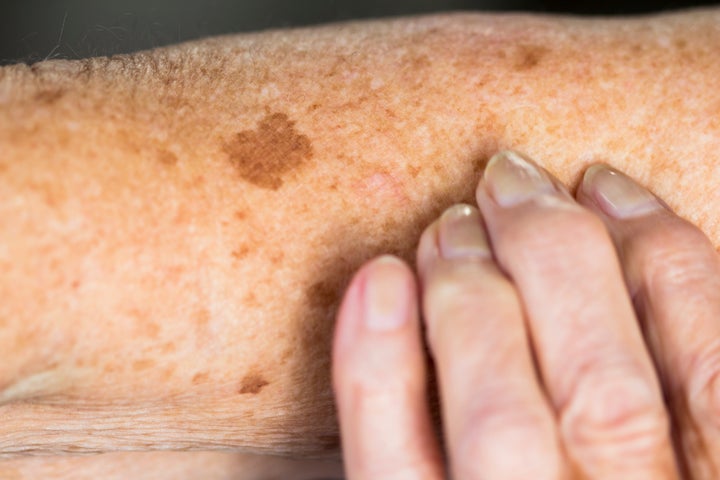
If you needed yet another reason to apply sunscreen this summer, the UK’s skin cancer stats might just push you to chuck some on.
With around 16,700 new melanoma skin cancer cases in the UK every year (or roughly 46 new diagnoses a day), the disease is the fifth most common cancer in Britain.
And while almost nine in 10 (87.4%) people diagnosed with melanoma skin cancer in England survive their disease for 10 years or more, the condition has better outcomes the earlier it’s caught.
So we thought we’d share some wisdom from expert oncology nurse, Mark Brown, to help you spot the warning signs that your age spot (sometimes known as sun or liver spots) could be melanoma – and what to do if you suspect it is.
It’s all about appearance
The easiest way to spot skin cancer is by looking at it.
“Age spots typically appear as small, flat, brown or black patches on areas of the skin that are frequently exposed to the sun, such as the face, hands, shoulders, and arms,” says Brown.
“They are usually uniform in colour and have well-defined edges. Skin cancer, on the other hand, may present as irregularly shaped or asymmetrical growths, with variations in colour, texture and size.”
He adds that age spots tend to stay the same shape and size over time, whereas skin cancer “can exhibit rapid growth and change in size, colour, or shape over weeks or months”.
It goes without saying then that new or changing lesions should be monitored closely.
Keep an eye on irregular, changing, differently-coloured, or oddly-textured new spots in particular – these are more likely to be a sign of melanoma.
Where you have the spot matters, too
Remember when we were talking about sunscreen earlier? Well, that’s because your chances of developing age spots are much higher in places where the sun hits your skin (as many of us probably already know).
But skin cancer, though often caused by sun damage, can show up anywhere on your skin, Brown says.
He suggests age spots commonly appear on the face, hands and areas frequently exposed to UV radiation.
Whereas skin cancer lesions can develop on any part of the body, including sun-protected areas, such as the palms, soles, genital region or inside the mouth.
So it’s important to monitor the areas the sun (literally) doesn’t shine, especially if you’re worried about skin cancer.
It matters how the spots feel, too
Spots caused by skin cancer can be more textured, wart-like, and even scaly, shared Brown – whereas age spots are more often flat and smooth.
And it’s not just how the spots themselves feel that matters – it’s about how you feel with them on your skin, too.
“Age spots generally do not cause any symptoms or discomfort. Skin cancer, however, can be accompanied by various symptoms, including itching, tenderness, pain or bleeding,” Brown says.
Consider your personal history
You’re more likely to develop skin cancer if you have a family history of the condition.
And age spots, well, tend to come with age. “Age spots, on the other hand, are common in individuals over 50 years old and are typically associated with cumulative sun exposure,” Brown says.
On top of that, consider your mole count. “The more moles you have on your body, the higher your risk of melanoma. One study found that melanoma risk was higher in people with more than 100 common moles, compared with people with fewer than 15 moles,“ says Cancer Research UK.
If you’re worried, see a doctor ASAP
If you notice anything worrying, Brown says, don’t delay in checking out your symptoms with a pro. And if they suggest it looks fine but you’re still worried, don’t be afraid to get a second opinion.
“If you have any concerns about a skin lesion or spot, it is recommended to consult a dermatologist or healthcare provider for a proper evaluation and diagnosis,” he says.
“Early detection and prompt medical attention are crucial in identifying and treating skin cancer effectively.”